Trademark Law: Case Study on Registration and Infringement Issues
VerifiedAdded on 2023/06/13
|9
|1825
|393
Case Study
AI Summary
This case study delves into the intricacies of trademark law, specifically focusing on registration and infringement issues within the context of Australian business law. It begins by defining a trademark under the Trade Mark Act 1995 (Cth), outlining the rights of registered owners and the requirements for application, including specifying goods and services. The study then presents a scenario involving Daniela, who intends to register "the tasty Llama" for her Peruvian food truck business, and analyzes potential challenges she might face regarding trademark infringement. By referencing Section 120 of the TMA and relevant case law such as Edgetec International v Zippykerb, the analysis determines whether Daniela's trademark is deceptively similar to an existing trademark (Trademark 2) owned by PETER CANNEY & ASSOCIATES PTY. LTD. The study considers defenses under Section 122 of the TMA, such as good faith use and the potential for Daniela's sign to be registered. Finally, it discusses the options available to Daniela if her trademark application is refused, emphasizing the need to amend the trademark to avoid similarity with existing registered marks. The document also includes a flowchart illustrating the trademark registration process.
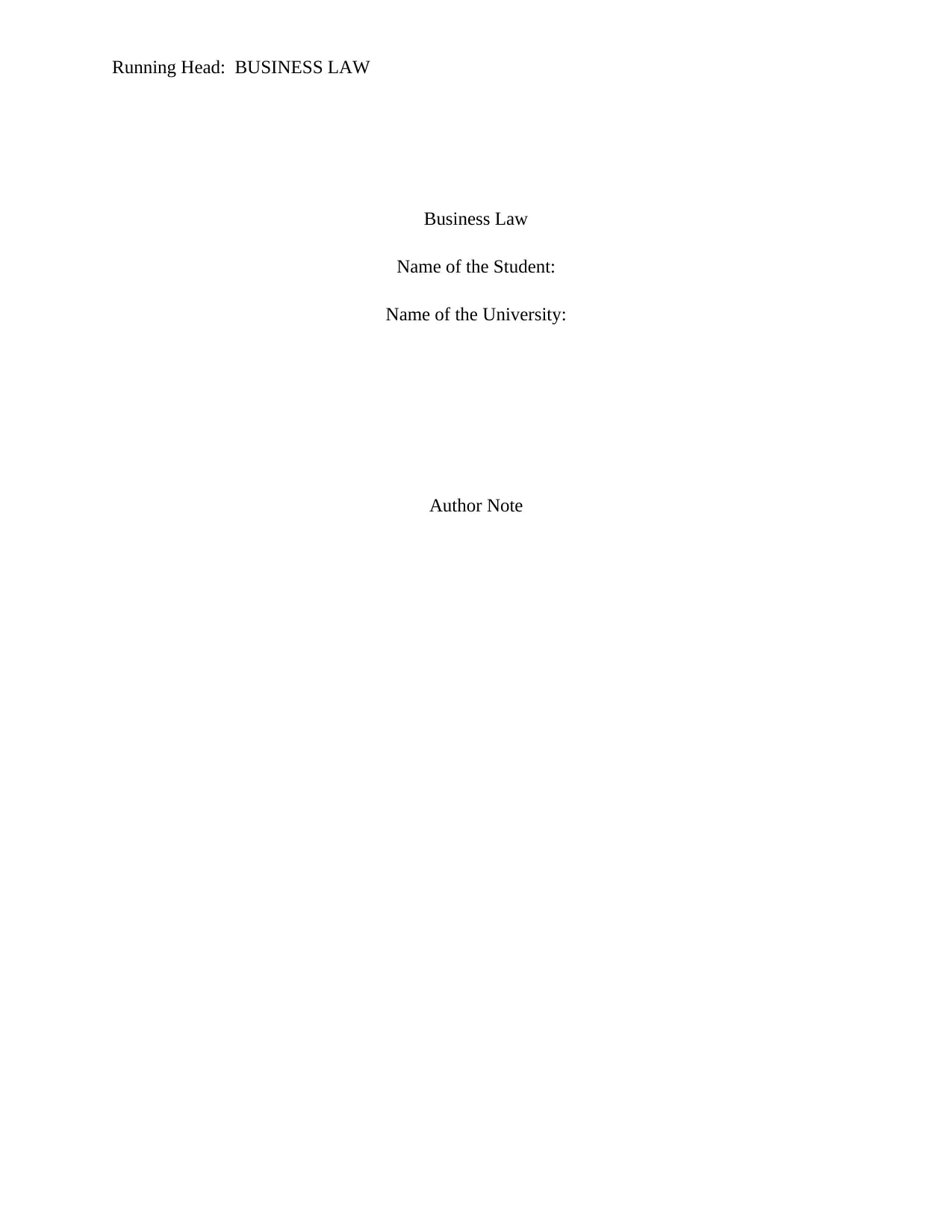
Running Head: BUSINESS LAW
Business Law
Name of the Student:
Name of the University:
Author Note
Business Law
Name of the Student:
Name of the University:
Author Note
Paraphrase This Document
Need a fresh take? Get an instant paraphrase of this document with our AI Paraphraser
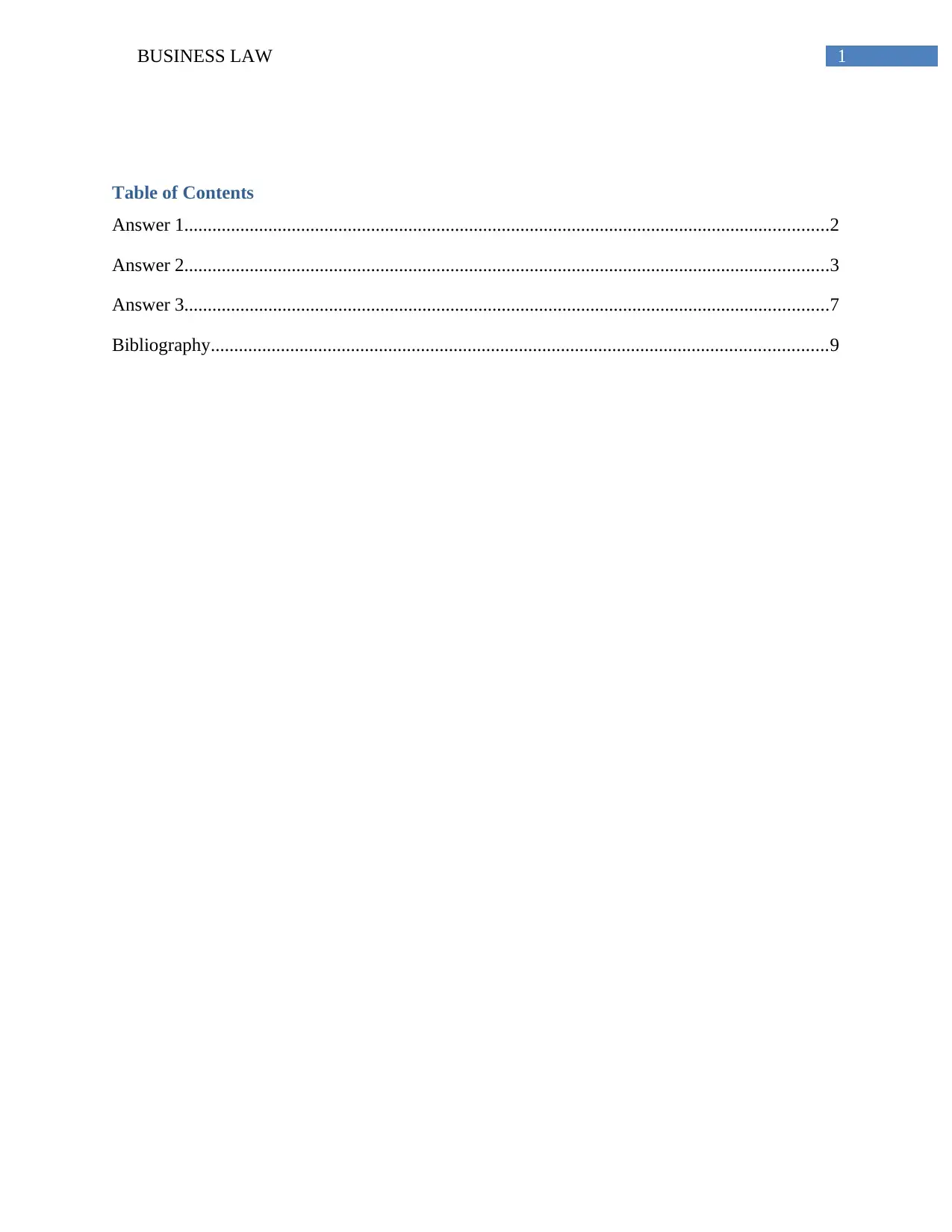
1BUSINESS LAW
Table of Contents
Answer 1..........................................................................................................................................2
Answer 2..........................................................................................................................................3
Answer 3..........................................................................................................................................7
Bibliography....................................................................................................................................9
Table of Contents
Answer 1..........................................................................................................................................2
Answer 2..........................................................................................................................................3
Answer 3..........................................................................................................................................7
Bibliography....................................................................................................................................9
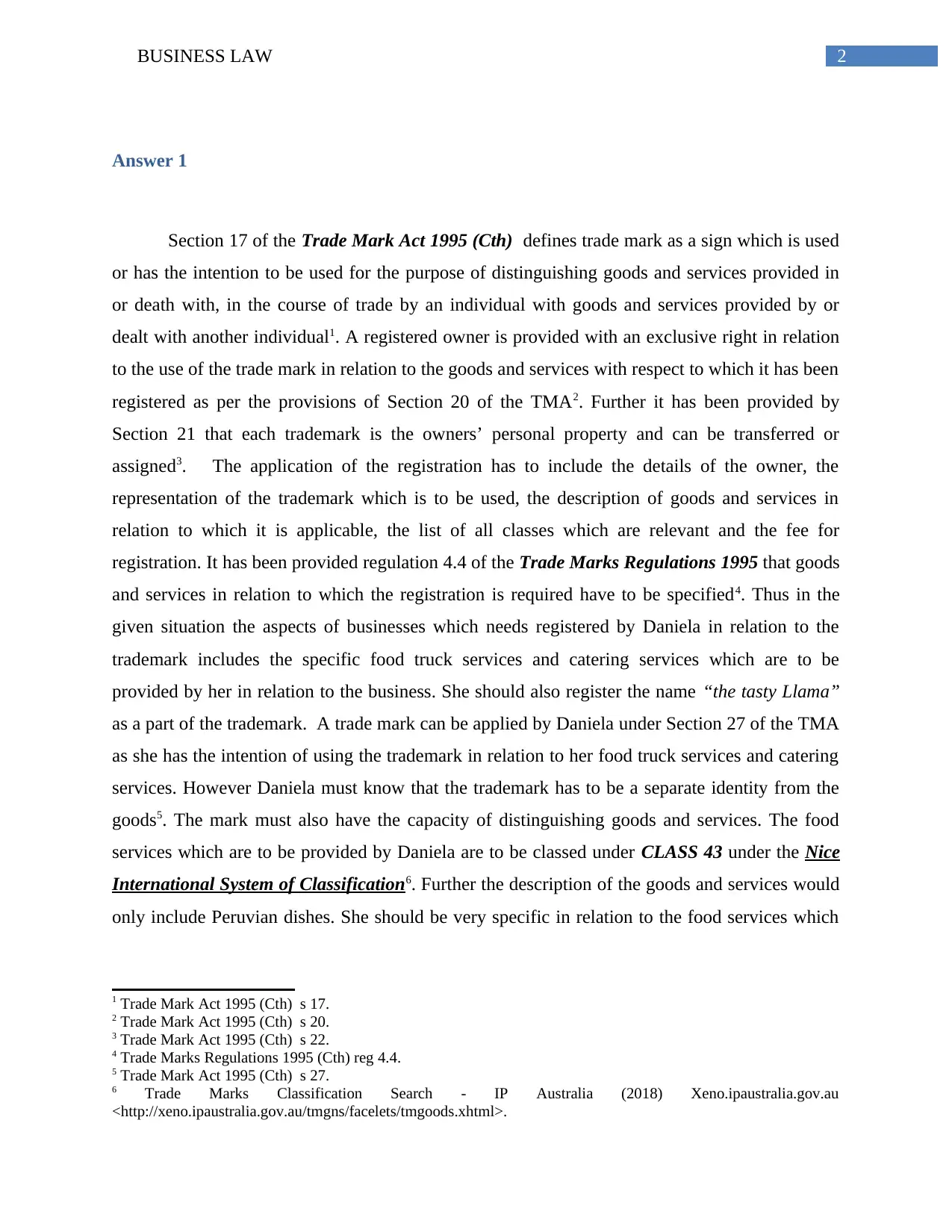
2BUSINESS LAW
Answer 1
Section 17 of the Trade Mark Act 1995 (Cth) defines trade mark as a sign which is used
or has the intention to be used for the purpose of distinguishing goods and services provided in
or death with, in the course of trade by an individual with goods and services provided by or
dealt with another individual1. A registered owner is provided with an exclusive right in relation
to the use of the trade mark in relation to the goods and services with respect to which it has been
registered as per the provisions of Section 20 of the TMA2. Further it has been provided by
Section 21 that each trademark is the owners’ personal property and can be transferred or
assigned3. The application of the registration has to include the details of the owner, the
representation of the trademark which is to be used, the description of goods and services in
relation to which it is applicable, the list of all classes which are relevant and the fee for
registration. It has been provided regulation 4.4 of the Trade Marks Regulations 1995 that goods
and services in relation to which the registration is required have to be specified4. Thus in the
given situation the aspects of businesses which needs registered by Daniela in relation to the
trademark includes the specific food truck services and catering services which are to be
provided by her in relation to the business. She should also register the name “the tasty Llama”
as a part of the trademark. A trade mark can be applied by Daniela under Section 27 of the TMA
as she has the intention of using the trademark in relation to her food truck services and catering
services. However Daniela must know that the trademark has to be a separate identity from the
goods5. The mark must also have the capacity of distinguishing goods and services. The food
services which are to be provided by Daniela are to be classed under CLASS 43 under the Nice
International System of Classification6. Further the description of the goods and services would
only include Peruvian dishes. She should be very specific in relation to the food services which
1 Trade Mark Act 1995 (Cth) s 17.
2 Trade Mark Act 1995 (Cth) s 20.
3 Trade Mark Act 1995 (Cth) s 22.
4 Trade Marks Regulations 1995 (Cth) reg 4.4.
5 Trade Mark Act 1995 (Cth) s 27.
6 Trade Marks Classification Search - IP Australia (2018) Xeno.ipaustralia.gov.au
<http://xeno.ipaustralia.gov.au/tmgns/facelets/tmgoods.xhtml>.
Answer 1
Section 17 of the Trade Mark Act 1995 (Cth) defines trade mark as a sign which is used
or has the intention to be used for the purpose of distinguishing goods and services provided in
or death with, in the course of trade by an individual with goods and services provided by or
dealt with another individual1. A registered owner is provided with an exclusive right in relation
to the use of the trade mark in relation to the goods and services with respect to which it has been
registered as per the provisions of Section 20 of the TMA2. Further it has been provided by
Section 21 that each trademark is the owners’ personal property and can be transferred or
assigned3. The application of the registration has to include the details of the owner, the
representation of the trademark which is to be used, the description of goods and services in
relation to which it is applicable, the list of all classes which are relevant and the fee for
registration. It has been provided regulation 4.4 of the Trade Marks Regulations 1995 that goods
and services in relation to which the registration is required have to be specified4. Thus in the
given situation the aspects of businesses which needs registered by Daniela in relation to the
trademark includes the specific food truck services and catering services which are to be
provided by her in relation to the business. She should also register the name “the tasty Llama”
as a part of the trademark. A trade mark can be applied by Daniela under Section 27 of the TMA
as she has the intention of using the trademark in relation to her food truck services and catering
services. However Daniela must know that the trademark has to be a separate identity from the
goods5. The mark must also have the capacity of distinguishing goods and services. The food
services which are to be provided by Daniela are to be classed under CLASS 43 under the Nice
International System of Classification6. Further the description of the goods and services would
only include Peruvian dishes. She should be very specific in relation to the food services which
1 Trade Mark Act 1995 (Cth) s 17.
2 Trade Mark Act 1995 (Cth) s 20.
3 Trade Mark Act 1995 (Cth) s 22.
4 Trade Marks Regulations 1995 (Cth) reg 4.4.
5 Trade Mark Act 1995 (Cth) s 27.
6 Trade Marks Classification Search - IP Australia (2018) Xeno.ipaustralia.gov.au
<http://xeno.ipaustralia.gov.au/tmgns/facelets/tmgoods.xhtml>.
⊘ This is a preview!⊘
Do you want full access?
Subscribe today to unlock all pages.

Trusted by 1+ million students worldwide
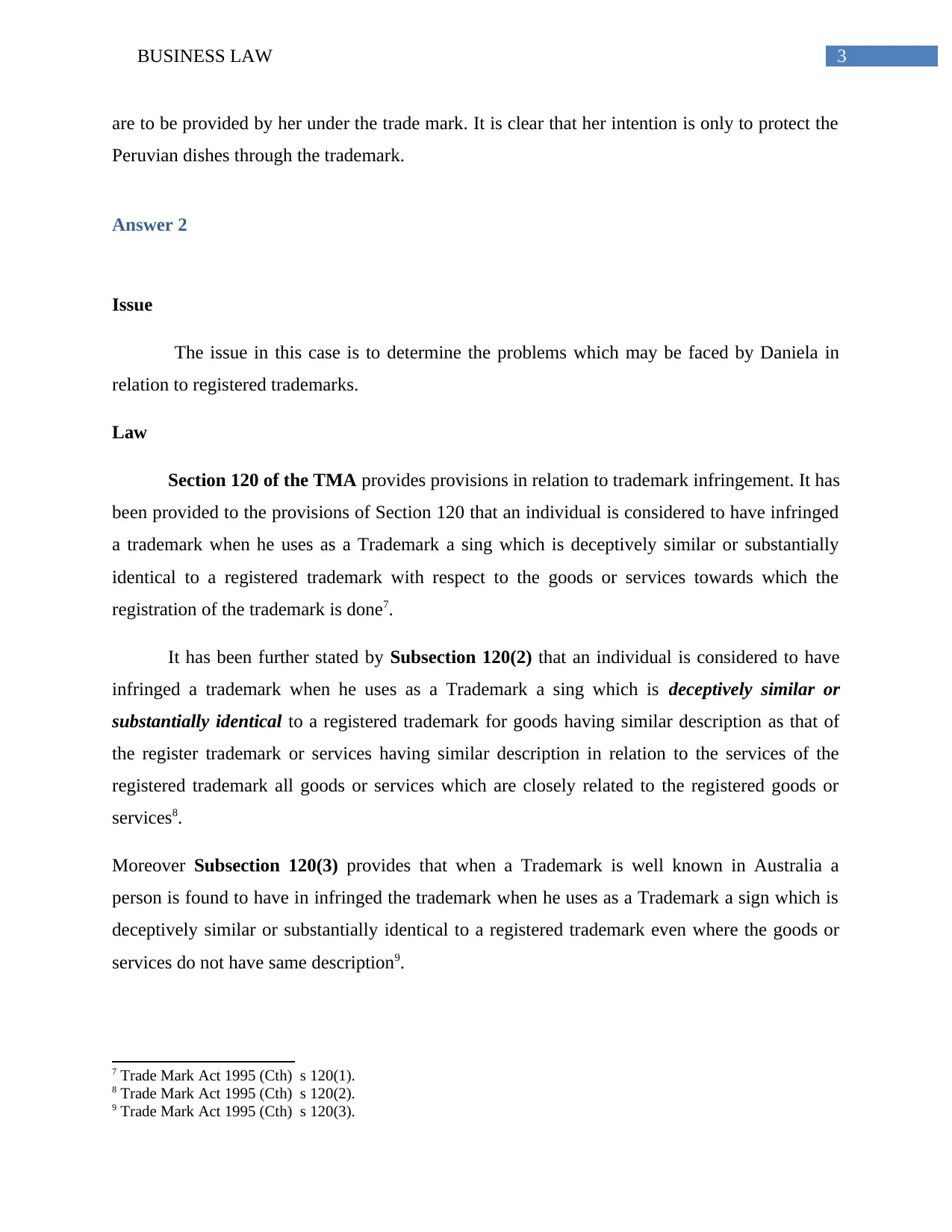
3BUSINESS LAW
are to be provided by her under the trade mark. It is clear that her intention is only to protect the
Peruvian dishes through the trademark.
Answer 2
Issue
The issue in this case is to determine the problems which may be faced by Daniela in
relation to registered trademarks.
Law
Section 120 of the TMA provides provisions in relation to trademark infringement. It has
been provided to the provisions of Section 120 that an individual is considered to have infringed
a trademark when he uses as a Trademark a sing which is deceptively similar or substantially
identical to a registered trademark with respect to the goods or services towards which the
registration of the trademark is done7.
It has been further stated by Subsection 120(2) that an individual is considered to have
infringed a trademark when he uses as a Trademark a sing which is deceptively similar or
substantially identical to a registered trademark for goods having similar description as that of
the register trademark or services having similar description in relation to the services of the
registered trademark all goods or services which are closely related to the registered goods or
services8.
Moreover Subsection 120(3) provides that when a Trademark is well known in Australia a
person is found to have in infringed the trademark when he uses as a Trademark a sign which is
deceptively similar or substantially identical to a registered trademark even where the goods or
services do not have same description9.
7 Trade Mark Act 1995 (Cth) s 120(1).
8 Trade Mark Act 1995 (Cth) s 120(2).
9 Trade Mark Act 1995 (Cth) s 120(3).
are to be provided by her under the trade mark. It is clear that her intention is only to protect the
Peruvian dishes through the trademark.
Answer 2
Issue
The issue in this case is to determine the problems which may be faced by Daniela in
relation to registered trademarks.
Law
Section 120 of the TMA provides provisions in relation to trademark infringement. It has
been provided to the provisions of Section 120 that an individual is considered to have infringed
a trademark when he uses as a Trademark a sing which is deceptively similar or substantially
identical to a registered trademark with respect to the goods or services towards which the
registration of the trademark is done7.
It has been further stated by Subsection 120(2) that an individual is considered to have
infringed a trademark when he uses as a Trademark a sing which is deceptively similar or
substantially identical to a registered trademark for goods having similar description as that of
the register trademark or services having similar description in relation to the services of the
registered trademark all goods or services which are closely related to the registered goods or
services8.
Moreover Subsection 120(3) provides that when a Trademark is well known in Australia a
person is found to have in infringed the trademark when he uses as a Trademark a sign which is
deceptively similar or substantially identical to a registered trademark even where the goods or
services do not have same description9.
7 Trade Mark Act 1995 (Cth) s 120(1).
8 Trade Mark Act 1995 (Cth) s 120(2).
9 Trade Mark Act 1995 (Cth) s 120(3).
Paraphrase This Document
Need a fresh take? Get an instant paraphrase of this document with our AI Paraphraser
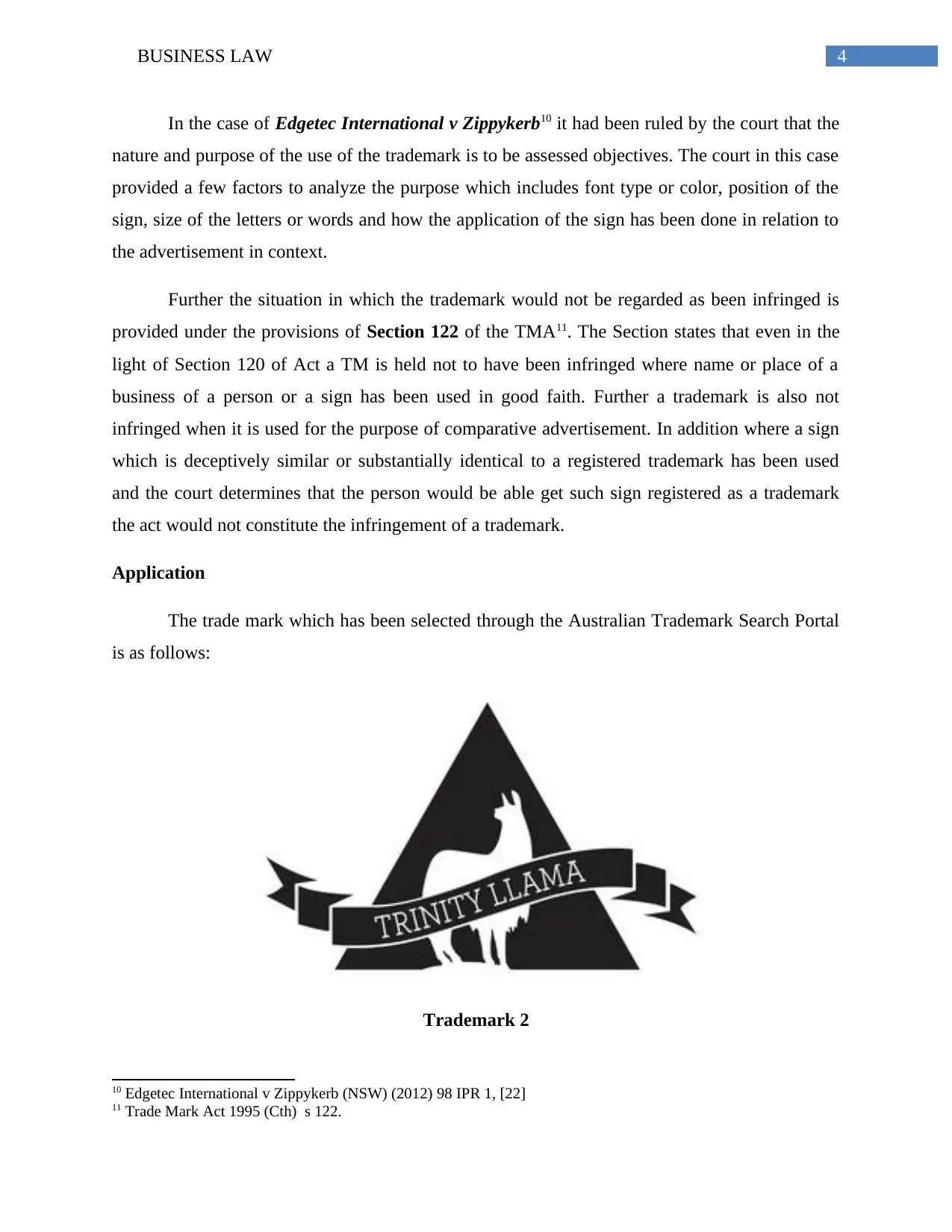
4BUSINESS LAW
In the case of Edgetec International v Zippykerb10 it had been ruled by the court that the
nature and purpose of the use of the trademark is to be assessed objectives. The court in this case
provided a few factors to analyze the purpose which includes font type or color, position of the
sign, size of the letters or words and how the application of the sign has been done in relation to
the advertisement in context.
Further the situation in which the trademark would not be regarded as been infringed is
provided under the provisions of Section 122 of the TMA11. The Section states that even in the
light of Section 120 of Act a TM is held not to have been infringed where name or place of a
business of a person or a sign has been used in good faith. Further a trademark is also not
infringed when it is used for the purpose of comparative advertisement. In addition where a sign
which is deceptively similar or substantially identical to a registered trademark has been used
and the court determines that the person would be able get such sign registered as a trademark
the act would not constitute the infringement of a trademark.
Application
The trade mark which has been selected through the Australian Trademark Search Portal
is as follows:
Trademark 2
10 Edgetec International v Zippykerb (NSW) (2012) 98 IPR 1, [22]
11 Trade Mark Act 1995 (Cth) s 122.
In the case of Edgetec International v Zippykerb10 it had been ruled by the court that the
nature and purpose of the use of the trademark is to be assessed objectives. The court in this case
provided a few factors to analyze the purpose which includes font type or color, position of the
sign, size of the letters or words and how the application of the sign has been done in relation to
the advertisement in context.
Further the situation in which the trademark would not be regarded as been infringed is
provided under the provisions of Section 122 of the TMA11. The Section states that even in the
light of Section 120 of Act a TM is held not to have been infringed where name or place of a
business of a person or a sign has been used in good faith. Further a trademark is also not
infringed when it is used for the purpose of comparative advertisement. In addition where a sign
which is deceptively similar or substantially identical to a registered trademark has been used
and the court determines that the person would be able get such sign registered as a trademark
the act would not constitute the infringement of a trademark.
Application
The trade mark which has been selected through the Australian Trademark Search Portal
is as follows:
Trademark 2
10 Edgetec International v Zippykerb (NSW) (2012) 98 IPR 1, [22]
11 Trade Mark Act 1995 (Cth) s 122.
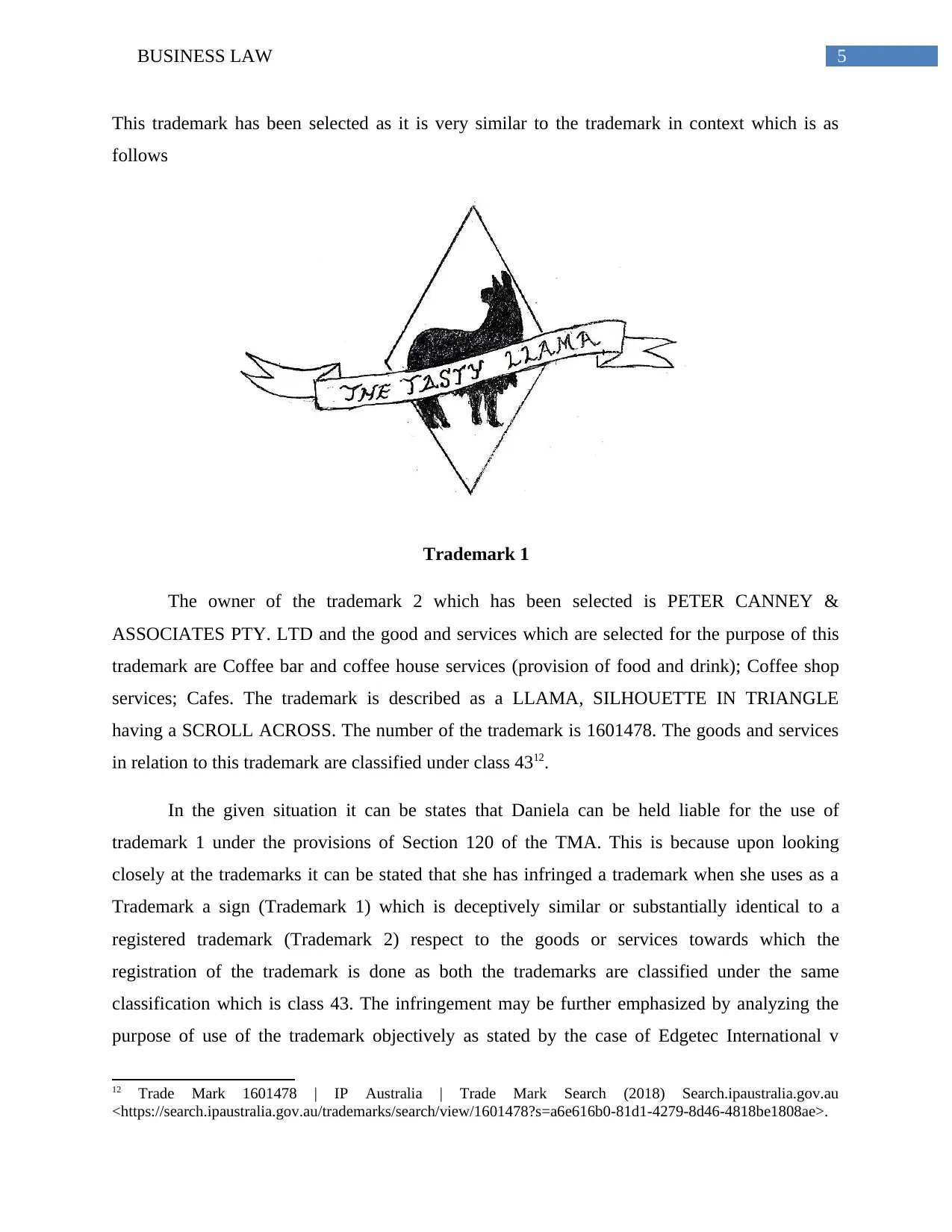
5BUSINESS LAW
This trademark has been selected as it is very similar to the trademark in context which is as
follows
Trademark 1
The owner of the trademark 2 which has been selected is PETER CANNEY &
ASSOCIATES PTY. LTD and the good and services which are selected for the purpose of this
trademark are Coffee bar and coffee house services (provision of food and drink); Coffee shop
services; Cafes. The trademark is described as a LLAMA, SILHOUETTE IN TRIANGLE
having a SCROLL ACROSS. The number of the trademark is 1601478. The goods and services
in relation to this trademark are classified under class 4312.
In the given situation it can be states that Daniela can be held liable for the use of
trademark 1 under the provisions of Section 120 of the TMA. This is because upon looking
closely at the trademarks it can be stated that she has infringed a trademark when she uses as a
Trademark a sign (Trademark 1) which is deceptively similar or substantially identical to a
registered trademark (Trademark 2) respect to the goods or services towards which the
registration of the trademark is done as both the trademarks are classified under the same
classification which is class 43. The infringement may be further emphasized by analyzing the
purpose of use of the trademark objectively as stated by the case of Edgetec International v
12 Trade Mark 1601478 | IP Australia | Trade Mark Search (2018) Search.ipaustralia.gov.au
<https://search.ipaustralia.gov.au/trademarks/search/view/1601478?s=a6e616b0-81d1-4279-8d46-4818be1808ae>.
This trademark has been selected as it is very similar to the trademark in context which is as
follows
Trademark 1
The owner of the trademark 2 which has been selected is PETER CANNEY &
ASSOCIATES PTY. LTD and the good and services which are selected for the purpose of this
trademark are Coffee bar and coffee house services (provision of food and drink); Coffee shop
services; Cafes. The trademark is described as a LLAMA, SILHOUETTE IN TRIANGLE
having a SCROLL ACROSS. The number of the trademark is 1601478. The goods and services
in relation to this trademark are classified under class 4312.
In the given situation it can be states that Daniela can be held liable for the use of
trademark 1 under the provisions of Section 120 of the TMA. This is because upon looking
closely at the trademarks it can be stated that she has infringed a trademark when she uses as a
Trademark a sign (Trademark 1) which is deceptively similar or substantially identical to a
registered trademark (Trademark 2) respect to the goods or services towards which the
registration of the trademark is done as both the trademarks are classified under the same
classification which is class 43. The infringement may be further emphasized by analyzing the
purpose of use of the trademark objectively as stated by the case of Edgetec International v
12 Trade Mark 1601478 | IP Australia | Trade Mark Search (2018) Search.ipaustralia.gov.au
<https://search.ipaustralia.gov.au/trademarks/search/view/1601478?s=a6e616b0-81d1-4279-8d46-4818be1808ae>.
⊘ This is a preview!⊘
Do you want full access?
Subscribe today to unlock all pages.

Trusted by 1+ million students worldwide
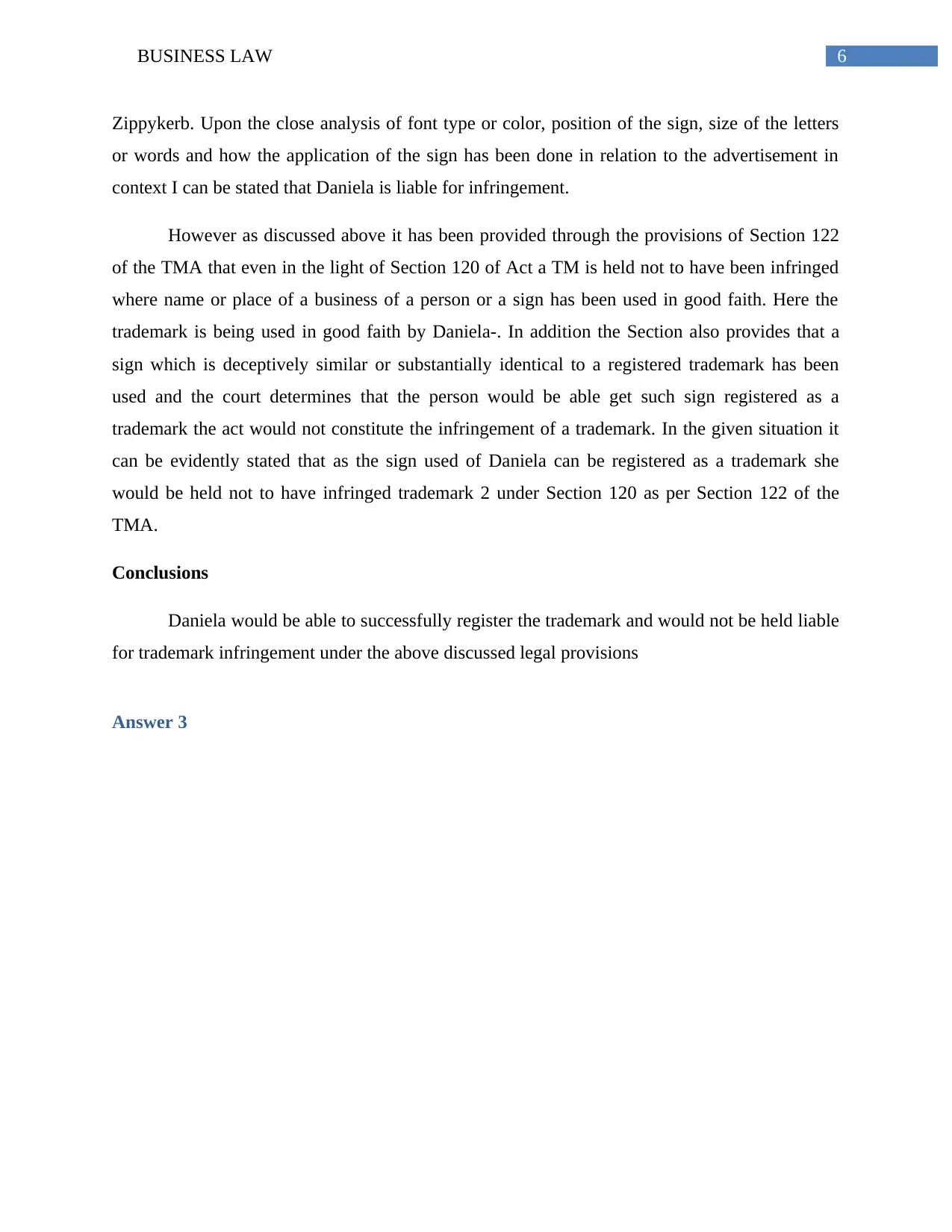
6BUSINESS LAW
Zippykerb. Upon the close analysis of font type or color, position of the sign, size of the letters
or words and how the application of the sign has been done in relation to the advertisement in
context I can be stated that Daniela is liable for infringement.
However as discussed above it has been provided through the provisions of Section 122
of the TMA that even in the light of Section 120 of Act a TM is held not to have been infringed
where name or place of a business of a person or a sign has been used in good faith. Here the
trademark is being used in good faith by Daniela-. In addition the Section also provides that a
sign which is deceptively similar or substantially identical to a registered trademark has been
used and the court determines that the person would be able get such sign registered as a
trademark the act would not constitute the infringement of a trademark. In the given situation it
can be evidently stated that as the sign used of Daniela can be registered as a trademark she
would be held not to have infringed trademark 2 under Section 120 as per Section 122 of the
TMA.
Conclusions
Daniela would be able to successfully register the trademark and would not be held liable
for trademark infringement under the above discussed legal provisions
Answer 3
Zippykerb. Upon the close analysis of font type or color, position of the sign, size of the letters
or words and how the application of the sign has been done in relation to the advertisement in
context I can be stated that Daniela is liable for infringement.
However as discussed above it has been provided through the provisions of Section 122
of the TMA that even in the light of Section 120 of Act a TM is held not to have been infringed
where name or place of a business of a person or a sign has been used in good faith. Here the
trademark is being used in good faith by Daniela-. In addition the Section also provides that a
sign which is deceptively similar or substantially identical to a registered trademark has been
used and the court determines that the person would be able get such sign registered as a
trademark the act would not constitute the infringement of a trademark. In the given situation it
can be evidently stated that as the sign used of Daniela can be registered as a trademark she
would be held not to have infringed trademark 2 under Section 120 as per Section 122 of the
TMA.
Conclusions
Daniela would be able to successfully register the trademark and would not be held liable
for trademark infringement under the above discussed legal provisions
Answer 3
Paraphrase This Document
Need a fresh take? Get an instant paraphrase of this document with our AI Paraphraser
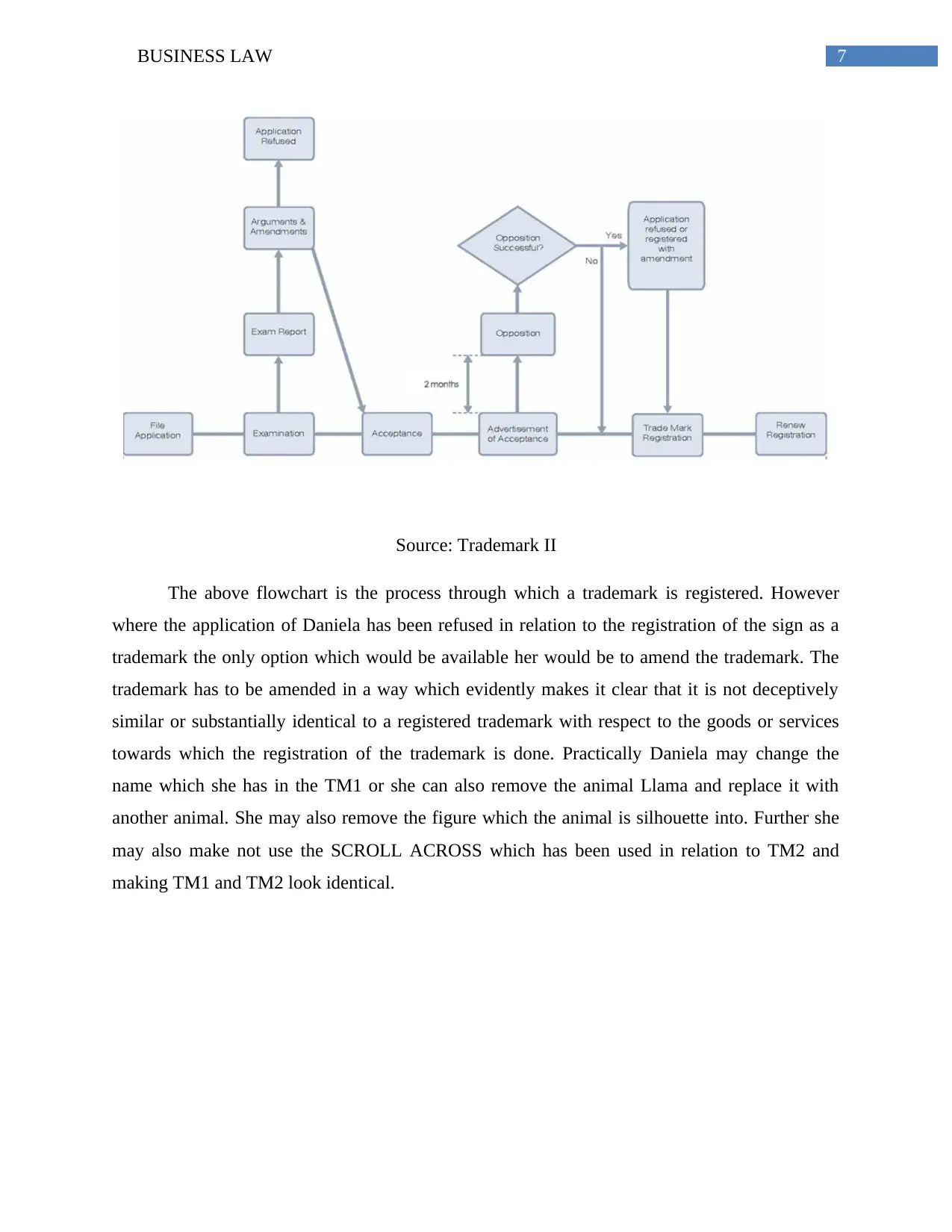
7BUSINESS LAW
Source: Trademark II
The above flowchart is the process through which a trademark is registered. However
where the application of Daniela has been refused in relation to the registration of the sign as a
trademark the only option which would be available her would be to amend the trademark. The
trademark has to be amended in a way which evidently makes it clear that it is not deceptively
similar or substantially identical to a registered trademark with respect to the goods or services
towards which the registration of the trademark is done. Practically Daniela may change the
name which she has in the TM1 or she can also remove the animal Llama and replace it with
another animal. She may also remove the figure which the animal is silhouette into. Further she
may also make not use the SCROLL ACROSS which has been used in relation to TM2 and
making TM1 and TM2 look identical.
Source: Trademark II
The above flowchart is the process through which a trademark is registered. However
where the application of Daniela has been refused in relation to the registration of the sign as a
trademark the only option which would be available her would be to amend the trademark. The
trademark has to be amended in a way which evidently makes it clear that it is not deceptively
similar or substantially identical to a registered trademark with respect to the goods or services
towards which the registration of the trademark is done. Practically Daniela may change the
name which she has in the TM1 or she can also remove the animal Llama and replace it with
another animal. She may also remove the figure which the animal is silhouette into. Further she
may also make not use the SCROLL ACROSS which has been used in relation to TM2 and
making TM1 and TM2 look identical.
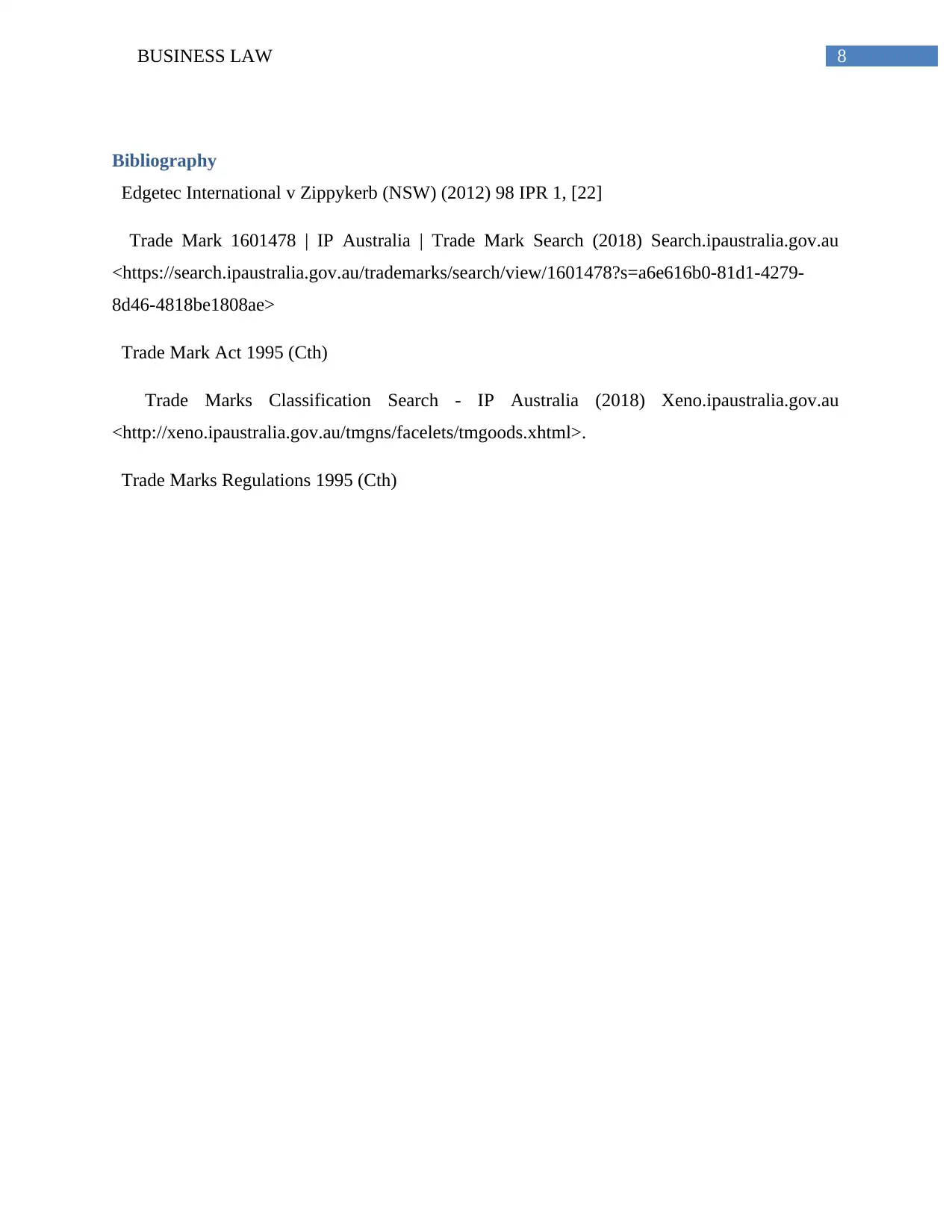
8BUSINESS LAW
Bibliography
Edgetec International v Zippykerb (NSW) (2012) 98 IPR 1, [22]
Trade Mark 1601478 | IP Australia | Trade Mark Search (2018) Search.ipaustralia.gov.au
<https://search.ipaustralia.gov.au/trademarks/search/view/1601478?s=a6e616b0-81d1-4279-
8d46-4818be1808ae>
Trade Mark Act 1995 (Cth)
Trade Marks Classification Search - IP Australia (2018) Xeno.ipaustralia.gov.au
<http://xeno.ipaustralia.gov.au/tmgns/facelets/tmgoods.xhtml>.
Trade Marks Regulations 1995 (Cth)
Bibliography
Edgetec International v Zippykerb (NSW) (2012) 98 IPR 1, [22]
Trade Mark 1601478 | IP Australia | Trade Mark Search (2018) Search.ipaustralia.gov.au
<https://search.ipaustralia.gov.au/trademarks/search/view/1601478?s=a6e616b0-81d1-4279-
8d46-4818be1808ae>
Trade Mark Act 1995 (Cth)
Trade Marks Classification Search - IP Australia (2018) Xeno.ipaustralia.gov.au
<http://xeno.ipaustralia.gov.au/tmgns/facelets/tmgoods.xhtml>.
Trade Marks Regulations 1995 (Cth)
⊘ This is a preview!⊘
Do you want full access?
Subscribe today to unlock all pages.

Trusted by 1+ million students worldwide
1 out of 9
Related Documents
Your All-in-One AI-Powered Toolkit for Academic Success.
+13062052269
info@desklib.com
Available 24*7 on WhatsApp / Email
![[object Object]](/_next/static/media/star-bottom.7253800d.svg)
Unlock your academic potential
Copyright © 2020–2025 A2Z Services. All Rights Reserved. Developed and managed by ZUCOL.





